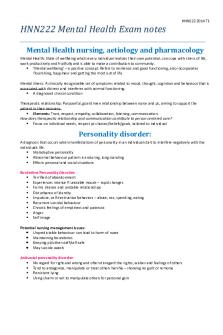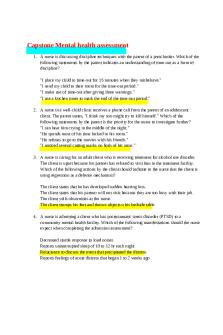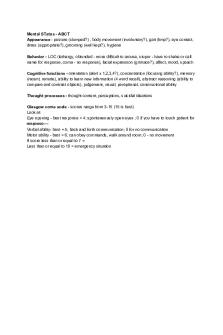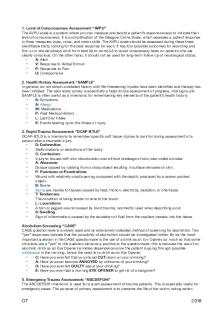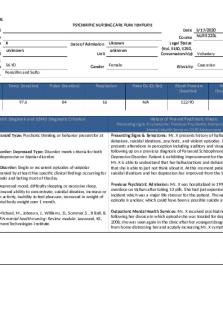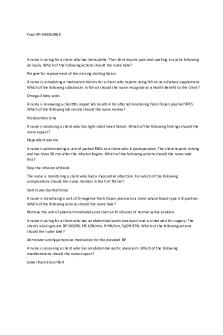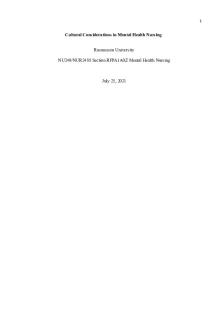Mental health nursing assessment 3 PDF

| Title | Mental health nursing assessment 3 |
|---|---|
| Author | Uřaş Upadhaya |
| Course | Mental Health Nursing |
| Institution | Australian Catholic University |
| Pages | 5 |
| File Size | 88.6 KB |
| File Type | |
| Total Downloads | 97 |
| Total Views | 153 |
Summary
Hi, this is a mental health nursing assignment 3....
Description
Mental health nursing, Assessment 3
Today I am going to present the case of Josh, he is 20 years old perusing his career in music, and he belongs to the indigenous family. Josh was diagnosed with depression at the age of 14, he is not the first person to suffer from mental illness in his family, with the help of his family, school, and Child and Youth Mental Health Services (CYMHS) he was able to recover. After a couple of years of receiving mental health services, Josh suddenly feels chest pain and shortness of breath, at first, Josh thinks that it is muscle pain, but it gets worst with time. When he visits the doctors, he finds out it was a panic attack, which makes him more worried, and he starts blaming himself for everything. Lately, Josh's behaviors were unusual he looks disorganized, sad, isolated, poor communication, worried, and looks miserable.
From an indigenous viewpoint, health includes not only physical well-being but also mental, cultural, and social well-being. Recent history has had a significant effect on the social and mental well-being of Australia's indigenous people. Emotional, social, and mental wellbeing have all been confirmed to suffer as a result. Thirty percent of the adult indigenous population has recorded high or very high levels of psychological stress, and 12% says they are depressed. Suicide rates in the indigenous population are twice as high as in the non-indigenous community. These high level of psychological distress and depression are associated with high rate of hospitalization and elevated mortality rate (Huether & MacCance, 2019).
In past, Josh experienced mental health issues as he felt lonely, tried to harm himself, isolating from peers’ group, feeling of weakness, which are a common sign and symptoms of depression (Bonful & Anum, 2019). So, Josh was prescribed Fluoxetine 20mg as a pharmacological treatment, Fluoxetine is also known as antidepressant medication which comes under 2nd generation antidepressant as a selective serotonin reuptake inhibitor (SSRI). Inpatient like Josh, SSRI treatment helps to increase the serotonin levels as the reuptake is blocked. Treatment with SSRI will also cause the number of postsynaptic receptors to decrease over time due to increased neurotransmitter availability (Tiziani, 2017). Genetic factors also play a vital role in developing depression, research says, “genetic factors account for 31-42% of the likelihood of developing major depressive disorder” (Huether & MacCance, 2019). In my case, Josh family has a history of mental illness from generation to generation as his mother, uncle, a cousin was the victim of mental illness. Environmental factors like stress, trauma, stressful life events can also contribute to depression as josh lives away from his family, he is not doing very well on this study, and the sudden death of his cousin can also trigger his anxiety and stress (Huether & MacCance, 2019).
One of the legal issues in this case scenario is involuntary or emergency admission, where a person with mental illness cannot identify their needs and try to harm themselves or others. An only authorized person like medical officer or a designated mental health care provider can treat against the wills of the person (van der Post et al., 2009). In my case, Josh was minor, and he was not able to make his own decision, where he was struggling to recognize his problem and considering himself week, as he was found attempting self-harm to himself by his school
coordinator, so Mr. Adams helped Josh to refer from school support to Child and Youth Mental Health Services (CYMHS)
One of the common adverse effects of antidepressant medication like Fluoxetine is suicidal thoughts in young age adult and adolescents (Dubicka et al., 2016). As a nurse, it is very important to assess the mental status of the patient, which provides the baseline information and current situation of the patient. Inpatient like Josh, looks anxious and isolated, it is crucial to maintain good communication which can help to build a good relationship. As Josh is trying to keep things within himself it is very important, we encourage Josh to communicate his feeling, ideas, thoughts, problems with someone. While communicating with Josh listen to him very carefully and consider his situation, do not jump to the conclusion, or frequently change the question. Effective communication can reduce Josh's fear and anxiety by expressing his feelings. It is not safe to leave Josh alone as there is a risk of suicide thoughts during antidepressant therapy and genetic factor that runs in Josh family.
Mental health evaluation, intervention, promotion, and prevention should provide holistic treatment underpinned by a biopsychosocial model, which is the role of a multidisciplinary team including psychiatry, nursing, occupational therapy, and psychology in caring for Josh. To provide effective treatment, each multidisciplinary participant should work within their disciplinary approach while also collaborating with others. Cognitive-behavioral therapy (CBT), for example, is advised to start in the acute stages of mental illness and be administered in a clinical inpatient environment (NICE, 2014; Royal College of Psychiatry, 2015). Nursing and medical management, health education and training can be effective in the delivery to
inpatients with multiple presentations, including depression, psychosis, and personality disorder (Paterson et al., 2018).
In conclusion, Josh encountered mental health illness at very young age, with good support and guidance he was benefited with the treatment, as he grew old, he came across different biopsychosocial factors which triggered his mental illness, as josh is taking fluoxetine as pharmacological treatment since he was 14years old. As a health care provider, it is our responsibility to deliver care to those who are experiencing a distressing mental health crisis and who are at risk to themselves and others, such as self-harm, suicidality, violence, and aggression.
Reference
Bonful, H., & Anum, A. (2019). Sociodemographic correlates of depressive symptoms: a crosssectional analytic study among healthy urban Ghanaian women. BMC Public Health, 19(1), 2,3. https://doi.org/10.1186/s12889-018-6322-8 Dubicka, B., Hadley, S., & Roberts, C. (2016). Suicidal behaviour in youths with depression treated with new-generation antidepressants. British Journal Of Psychiatry, 189(5), 393398. https://doi.org/10.1192/bjp.bp.105.011833 Huether, S., & MacCance, K. (2019). Understanding pathophysiology (6th ed., pp. 1203-1205). Elsevier.
NICE. (2014). Psychosis and schizophrenia in adults: treatment and management. London: National Institute of Clinical Excellence. Paterson, C., Karatzias, T., Dickson, A., Harper, S., Dougall, N., & Hutton, P. (2018). Psychological therapy for inpatients receiving acute mental health care: A systematic review and metaanalysis of controlled trials. British Journal Of Clinical Psychology, 57(4), 453-472. https://doi.org/10.1111/bjc.12182 Royal College of Psychiatry (2015) Standards for Inpatient Mental Health Services. London: Royal College of Psychiatry. Tiziani, A. (2017). Havard's Nursing Guide to Drugs - Mobile optimised site (10th ed., pp. 253256). Elsevier Health Sciences. van der Post, L., Mulder, C., Bernardt, C., Schoevers, R., Beekman, A., & Dekker, J. (2009). Involuntary Admission of Emergency Psychiatric Patients: Report From the Amsterdam Study of Acute Psychiatry. Psychiatric Services, 60(11), 1543-1546. https://doi.org/10.1176/ps.2009.60.11.1543...
Similar Free PDFs

Uworld Mental Health Nursing
- 168 Pages
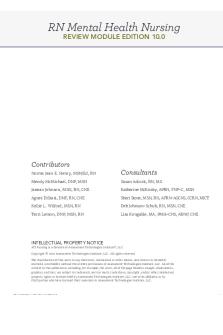
ebook for mental health nursing
- 219 Pages
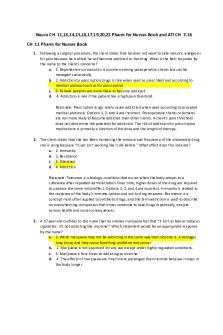
ATI TEST - mental health nursing
- 38 Pages
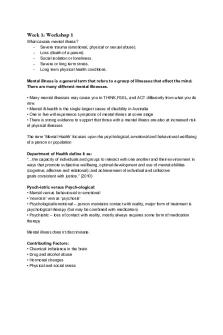
Nursing and Mental Health 1 Notes
- 62 Pages
Popular Institutions
- Tinajero National High School - Annex
- Politeknik Caltex Riau
- Yokohama City University
- SGT University
- University of Al-Qadisiyah
- Divine Word College of Vigan
- Techniek College Rotterdam
- Universidade de Santiago
- Universiti Teknologi MARA Cawangan Johor Kampus Pasir Gudang
- Poltekkes Kemenkes Yogyakarta
- Baguio City National High School
- Colegio san marcos
- preparatoria uno
- Centro de Bachillerato Tecnológico Industrial y de Servicios No. 107
- Dalian Maritime University
- Quang Trung Secondary School
- Colegio Tecnológico en Informática
- Corporación Regional de Educación Superior
- Grupo CEDVA
- Dar Al Uloom University
- Centro de Estudios Preuniversitarios de la Universidad Nacional de Ingeniería
- 上智大学
- Aakash International School, Nuna Majara
- San Felipe Neri Catholic School
- Kang Chiao International School - New Taipei City
- Misamis Occidental National High School
- Institución Educativa Escuela Normal Juan Ladrilleros
- Kolehiyo ng Pantukan
- Batanes State College
- Instituto Continental
- Sekolah Menengah Kejuruan Kesehatan Kaltara (Tarakan)
- Colegio de La Inmaculada Concepcion - Cebu

